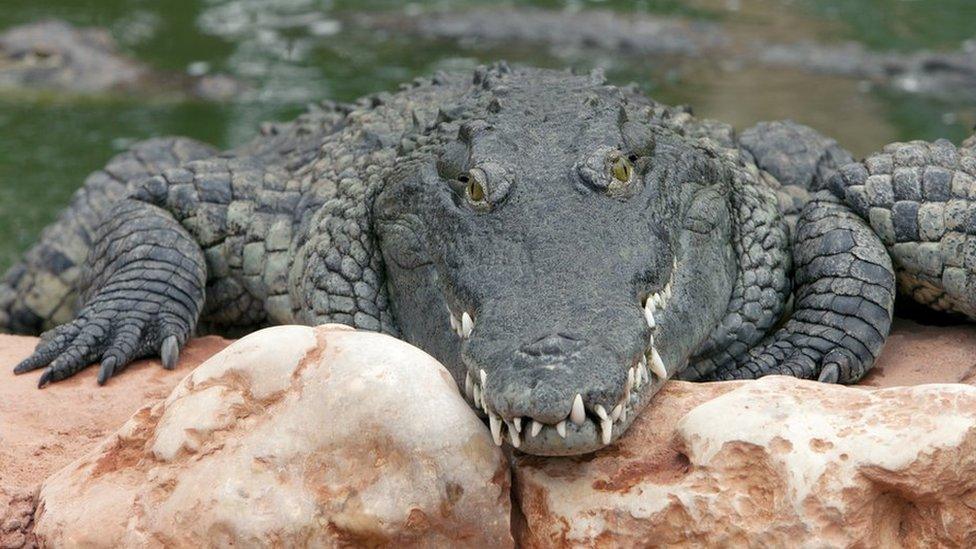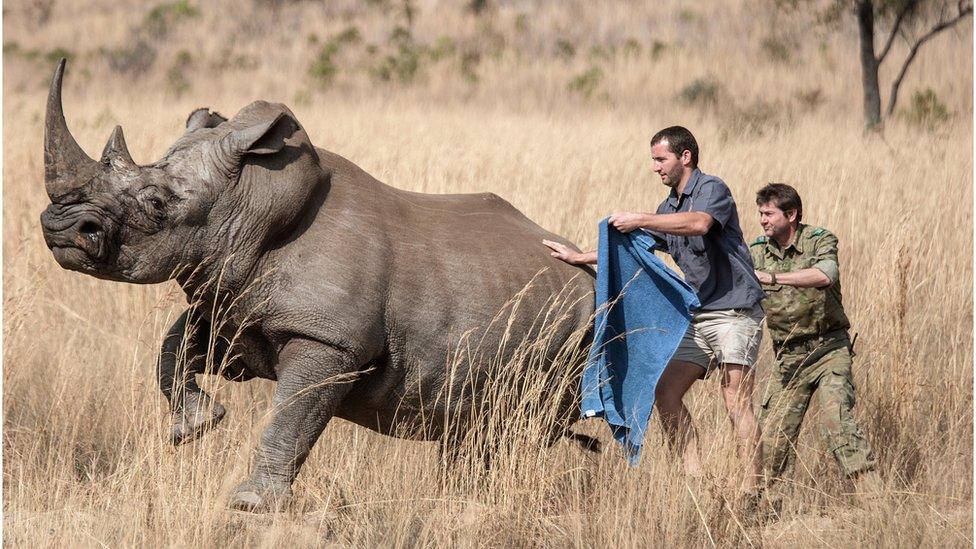CITES species meeting: 'The only game in town'
- Published

Poster boy: Between the 1940s and 1970s, the Nile crocodile suffered from over-zealous hunting
A big hand for the Nile Crocodile, the poster animal for the argument that regulated international trade can save endangered species.
Though perhaps a gentle round of applause from a suitable distance might be a tad more appropriate.
For as well as being a fearsome killer of humans, or anything else that strays into its path, the green eyed monstrous nile croc is also the source of a highly valued leather, that fashion houses turn into expensive handbags, belts and shoes.
Between the 1940s and 1970s, over zealous hunting caused these thick skinned creatures to be listed on the IUCN Red List as endangered in many parts of sub-Saharan Africa and Madagascar.
Fast forward 50 years and nile crocodiles are doing reasonably well. They are no longer listed as endangered and organised crocodile farms meet the demand for their skins without threatening the wild populations.
So what changed?
Red tape replaced Red Lists thanks to CITES, the Convention on the International Trade in Endangered Species of Wild Fauna and Flora.
The text of the Convention was agreed at a conference of 80 countries in Washington in 1973, when the plight of the crocodile and many other species had caused enough international concern to force action.
The treaty entered into force on 1 July 1975, with the Nile Crocodile listed in Appendix I, the most serious designation, meaning all commercial trade in the species was severely restricted.
CITES seeks to limit the voracious human appetite for almost every other species through exploiting another human trait - our love of money.

Here, vets try to help a rhino in Pilanesberg National Park, South Africa. Rhinos are threatened by the massive rise in poaching
CITES organises and regulates the trade in endangered species through the use of three appendices that list and control the buying and selling of plants and animals, depending on the level of threat they face.
Each country can unilaterally nominate species onto Appendix III, the lowest category.
Essentially, it's a notification to other countries that this species is under threat and that help is required to control international trade. There are fewer than 150 species on this list, including walruses and some stag beetles.
Species have to be voted on to the other two appendices by the member states, that now number 183 countries. Big decisions about species are taken at a major meeting called the Conference of the Parties, which takes place every three years or so, with COP17 set to start in Johannesburg on 24 September.
Appendix operation
Appendix II includes species that are currently not threatened with extinction but may become so without strong trade controls. There are over 30,000 on this listing, the vast majority plants and trees.
An export permit is needed for trade in Appendix II, and that is issued by the management authority in the country of the species. No import licence is necessary. Some species on this list include sharks, polar bears and lions across Africa.
Appendix I is the most restrictive control and is reserved for around 1,000 species that are in danger of extinction.
Commercial trade in these species is not allowed, although captive bred members of the species are treated as Appendix II and can be bought and sold. As well as a certified export permit, the management authority of the country exporting must make a non-detrimental declaration and the importing country must have a permit as well.
Tigers, rhinos, gorillas are on this list. But sometimes there are so-called split listings to reflect the fact that the same species in different countries can be doing better or worse.
Elephants for instance, are listed as Appendix II in four southern African countries, but are Appendix I everywhere else. Attempts to up-list all elephants in Africa to the highest level of protection are likely to provoke the biggest arguments at this year's Conference of the Parties.
Exotic and collectable
Going back to the Nile Crocodile, the effectiveness of the CITES regulations can be seen in the case of Mrs Smouha and her £2,000 croc skin handbag.
The leather came from the skin of an animal that was raised at a regulated farm in Zimbabwe where the crocodile is considered Appendix II. It was exported legitimately to Japan with a permit and fashioned into an expensive bag, which caught the eye of Mrs Smouha and was duly purchased by her husband as a gift.
Upon entering the UK though, sharp-eyed customs officers noticed the bag didn't have a re-export licence from Japan and seized it.
After a prolonged court battle, Mrs Smouha was re-united with her handbag, as she was deemed not have done anything wrong.
Some people seriously object to the idea of farming animals like crocodiles for their skins but there is little doubt that the legitimate, organised trade is meeting a need that without CITES could drive the species to extinction.
But can it do the same when faced with the massive rise in poaching that is threatening elephants and rhinos? Can it cope with the so-called medical demand for lion and tiger bones and pangolin scales? Can it control our human love of the exotic and the collectable - a quirk that is driving species like cheetahs and the African Grey Parrot to the verge?
It can have some impact - but the world is perhaps putting too much responsibility on its shoulders.
"CITES deals with international trade, it is not there to deal with the conservation of species in situ - there is a great deal of misunderstanding about that," said John Sellar, formerly chief of enforcement for CITES.
"CITES is not an organisation, it is a treaty - if it 'succeeds or fails', it is because of what happens at a national level to implement the provisions of the convention, in and of itself it can do very little."
"There is no overarching body unfortunately, that can wave a magic wand and get all this right.
"But CITES is undoubtedly the only game in town at the moment. There simply isn't an alternative."